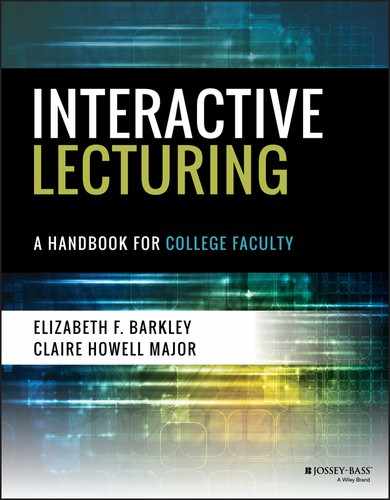ENGAGING LECTURE TIP 4
Presentation Persona
Part of being an effective teacher is being comfortable with yourself, knowing who you are, and identifying how you can best convey that to students; in short, it is helpful to know your teaching persona and how best to share it with students. A teaching persona is the aspect of your character related to your role as a teacher that you present to students. Students will perceive some of your persona—for example, your age, gender, level of fitness—without your attempts to convey it. Similarly, your choices of what to wear, the number and size of your bags and carrying cases you bring to class, whether you choose to use technology or not, how you address the students, and so forth also convey persona to students.
A Presentation Persona is a subset of a teaching persona. It is who you are as a speaker, a lecturer. It should flow naturally from your teaching persona and should also guide you in your decisions as a presenter. Your Presentation Persona should be something that is authentic and unique to you. Identifying a clear Presentation Persona can help you deliver better, more-focused, and more-credible lecture presentations. It can also signal students as to your intent.
There are several presenter archetypes in public speaking literature that can help you think about who you are as a teacher-presenter. For example, are you a data scientist? An inventor? A storyteller? A coach? Other? In Figure 3.1, which we adapted from Teteak (2013), we offer a way to get started on thinking about who you are as a presenter.

Figure 3.1 Presenter Archetypes
Aspects
You can begin to consider who you are as a speaker by considering where you think you fall along two different continua.
- Thinking-Feeling. You may have an idea of your stance on this aspect from a Myers-Briggs inventory. Are you motivated by your thinking mind, the one that likes to use logic, weigh evidence, and consider pros and cons? Or are you more motivated by your feeling mind, the one prompted by values, compassion, and idealism?
- Reflection-Action. Reflection refers to your preference for having time to think before reacting or for moving quickly into action and doing, for example, hands-on activities.
Archetypes
You can also consider whether you fall into one of the following archetypes:
- Fascinators. Fascinators share wisdom and information, convincing and reassuring students that they are reliable sources. They enjoy sharing important information as well as trivia and are prepared and often anticipate audience questions. Examples of fascinators include Sir Ken Robinson, Temple Grandin, and Susan Cain.
- Inspirers. Inspirers convey their enthusiasm and spirit and are often storytellers, who use stories to make a point. They are empathetic, caring, and like people, which makes an audience feel safe. They work to build credibility and rapport, often sharing their feelings rather than leaving them for the audience to guess. Examples of inspirers include Martin Luther King Jr., Barack Obama, and Jill Bolte Taylor.
- Energizers. Energizers endear with their enthusiasm, building the audience's confidence and firing them up with energy to go out and do something. They welcome competition and challenges. They are passionate and have leadership qualities and a strong presence. Examples of energizers include Tony Robbins and Erin Gruwell.
- Performers. Performers entertain their audiences. They enjoy the spotlight and use body language, their voices, and their words to model key concepts and explanations. They enjoy and feed off of the audience's energy. Examples of performers include Bill Clinton and Angelina Jolie.
In practice, we are typically a combination of different archetypes. For example, most college lecturers will likely identify with the fascinator role—if we are lecturing, we are probably trying to share our knowledge and wisdom with others. But we also want to inspire students to achieve, maybe even to energize them into carrying on their studies in our field or to go forth to make a difference in the world. We also likely want that information to be interesting, and although we might resist the idea that a college lecture should be entertaining, good speakers recognize that part of effective lecturing is in fact performance; a great lecture is a work of art. Whatever qualities constitute your preferred presentation persona, recognizing and refining them can help you deliver your lectures more effectively.
Example
Key References and Resources
- Grabowski, P. (2016, January 28). How to deliver an unforgettable pitch by finding your presentation style [Web log post]. Retrieved August 18, 2016, from https://attach.io/blog/deliver-an-unforgettable-pitch-by-finding-your-presentation-style/
- Teteak, J. (2013, October 21). Find your presentation style. Retrieved from http://ruletheroom.com/find-your-presentation-style/
